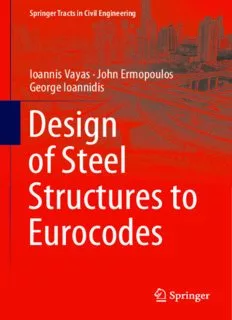
Design of Steel Structures to Eurocodes PDF
Preview Design of Steel Structures to Eurocodes
Springer Tracts in Civil Engineering Ioannis Vayas · John Ermopoulos George Ioannidis Design of Steel Structures to Eurocodes Springer Tracts in Civil Engineering Springer Tracts in Civil Engineering (STCE) publishes the latest developments in Civil Engineering—quickly, informally and in top quality. The series scope includes monographs, professional books, graduate textbooks and edited volumes, aswellasoutstandingPh.D.theses.Itsgoalistocoverallthemainbranchesofcivil engineering, both theoretical and applied, including: Construction and Structural Mechanics Building Materials Concrete, Steel and Timber Structures Geotechnical Engineering Earthquake Engineering Coastal Engineering Hydraulics, Hydrology and Water Resources Engineering Environmental Engineering and Sustainability Structural Health and Monitoring Surveying and Geographical Information Systems Heating, Ventilation and Air Conditioning (HVAC) Transportation and Traffic Risk Analysis Safety and Security Tosubmitaproposalorrequestfurtherinformation,pleasecontact:PierpaoloRiva at [email protected], or Li Shen at [email protected] More information about this series at http://www.springer.com/series/15088 Ioannis Vayas John Ermopoulos (cid:129) George Ioannidis Design of Steel Structures to Eurocodes 123 Ioannis Vayas George Ioannidis Schoolof Civil Engineering National Technical University of Athens National Technical University of Athens Athens, Greece Athens, Greece JohnErmopoulos National Technical University of Athens Athens, Greece ISSN 2366-259X ISSN 2366-2603 (electronic) SpringerTracts inCivil Engineering ISBN978-3-319-95473-8 ISBN978-3-319-95474-5 (eBook) https://doi.org/10.1007/978-3-319-95474-5 LibraryofCongressControlNumber:2018962122 ©SpringerNatureSwitzerlandAG2019 Thisworkissubjecttocopyright.AllrightsarereservedbythePublisher,whetherthewholeorpart of the material is concerned, specifically the rights of translation, reprinting, reuse of illustrations, recitation, broadcasting, reproduction on microfilms or in any other physical way, and transmission orinformationstorageandretrieval,electronicadaptation,computersoftware,orbysimilarordissimilar methodologynowknownorhereafterdeveloped. The use of general descriptive names, registered names, trademarks, service marks, etc. in this publicationdoesnotimply,evenintheabsenceofaspecificstatement,thatsuchnamesareexemptfrom therelevantprotectivelawsandregulationsandthereforefreeforgeneraluse. The publisher, the authors and the editors are safe to assume that the advice and information in this book are believed to be true and accurate at the date of publication. Neither the publisher nor the authorsortheeditorsgiveawarranty,expressorimplied,withrespecttothematerialcontainedhereinor for any errors or omissions that may have been made. The publisher remains neutral with regard to jurisdictionalclaimsinpublishedmapsandinstitutionalaffiliations. ThisSpringerimprintispublishedbytheregisteredcompanySpringerNatureSwitzerlandAG Theregisteredcompanyaddressis:Gewerbestrasse11,6330Cham,Switzerland Preface Buildingscharacterizeurbanareasandarerelatedtothepersonal,socialandprofes- sionalactivitiesofpeople.Theselectionoftheappropriatematerialsforitsstructural elements (reinforced concrete, steel, aluminum, wood, masonry), depends on the characteristics of the building and the design criteria, such as economic, aesthetic, functional, execution time, as well as the conditions of soil quality and seismicity oftheconstructionarea.Steel,asamainstructuralmaterial,isusedinallcountries, inadifferentbycountryextent,dependingonthelocalconditionsandtheexisting traditionintheconstructionmethods.Steelbuildingsmaybedistinguishedinsingle andmultistorey.Singlestoreysteelbuildingsaremainlyerectedforindustrial,com- mercial,warehousingandsportsapplications.Multistoreyconstructionsaremainly usedforresidentialorofficepurposes. Thedesignandfabricationofbuildingsareperformedfollowingrulesprovidedin specificationsandCodes.Duringthelastdecades,anextendedprogramofcommon CodesforallEuropeancountrieswasdeveloped,calledEurocodes,coveringbothde- signandfabricationissues,inordertofacilitatemobilityofconstructioncompanies, design offices and engineers in the area of the European Community and beyond it. In addition the cooperation between authorities and technical organizations and personnel,comingfromdifferentcountries,shouldbecomeeasier. This book presents the rules for the design of steel buildings according to the aboveEurocodes,coveringthestructureasawhole,aswellasthedesignofindivid- ualstructuralmembersandconnections.Thepresentationissupplementedbymany numericalexamples.Specificsectionsofthebookarededicatedtotheconceptualde- sign,thefabricationanderectionphasesandthequalityrequirements.Rulesforthe seismicdesign,whenrequired,arealsoincluded.Thetextisorganizedin9chapters. Chapters1-5dealwiththemethodsofanalysis,thelimitstatesofdesignandthere- sistancesofcross-sections,membersandconnections,whilechapters6-8arerelated totheconceptualdesignofsingleandmultistoreybuildingsaswellastothefabri- cationmethodsandthequalitycontrol.Chapter9includesnumericalapplicationsof thedesignrulesintheformof52designexamples. Chapter 1 presents the bases of design, in the frame of Eurocodes, the actions applied to building structures, the load combinations for the various limit states of design,aswellasthemainsteelpropertiesandthesteelfabricationmethods. VI Chapter2dealswiththemodelsandmethodsofstructuralanalysis,incombina- tion with thestructural imperfections and the cross-sectionclassification according totheircompactness. Chapter 3 discusses the cross-sections resistances, when subjected to axial and shearforces,bendingortorsionmomentsandtocombinationsoftheabove. Chapter 4 presents the members design and more specifically the design of members sensitive to instability phenomena, such as flexural, torsional and lateral- torsionalbuckling.Aparticularsectionisdevotedtocompositebeams. Chapter 5 refers to the design of connections and joints executed by bolting or welding,includingbeamtocolumnconnectionsinframestructures. Chapter 6 discusses alternative configurations to be considered during the con- ceptualdesignphaseofdifferenttypesofsinglestoreybuildings.Thedesignofcrane supportingbeamsisdiscussedinaspecialsection. Chapter7givesinformationaboutthestructuralelementsandsystemsofmulti storeybuildings,especiallythoseensuringtheiroverallstabilityalongtheheight,as wellasaboutthealternativeconfigurationsthatcouldbeapplied. Chapter8referstothefabricationanderectionprocedures,aswellastherelated quality requirements and the quality control methods. The procedures for bolting, weldingandsurfaceprotectionareincluded. Chapter9presentsfiftytworepresentativenumericalexamples,basedonthede- signrulesfortheverificationofcross-sectionsandmembers,subjectedtotheusual types of loading, the verification of bolted and welded connections, as well as for specific items such as hollow sections’ joints, uniform built-up compression mem- bers or column bases. The calculation steps are directly related in the text with the correspondingparagraphsofEurocodes. Thebookisaddressedtothestructuralengineeringstudents,toyoungengineers workinginthefieldofdesignorconstructionofsteelbuildings,aswellastoengi- neersnotfamiliarwiththeregulationsofEurocodes. Acknowledgments WewouldliketothankthefollowingPhDstudentsatNTUAforpreparingFigures, TablesandprovidingTechnicalsupport:StellaAvgerinou,Maria-EleniDasiouand Zacharias Fasoulakis. We also thank Dr. Kostis Kalochairetis for his comments on partofthetext. About the Authors IoannisVayasisprofessoranddirectoroftheInstituteofSteelStructuresattheNa- tionalTechnicalUniversityofAthens.Hegraduatedincivilengineeringatthesame universityandreceivedhisDr.-Ing.fromtheTechnicalUniversityofBraunschweig, GermanyandhisweldingEngineerspecializationfromSLVHannover,Germany.He has been involved in research, national and European codification and consultancy onsteelstructuresforover40years. JohnErmopoulosisprofessoremeritusandformerdirectoroftheInstituteofSteel Structures at the National Technical University of Athens. He graduated from the SchoolofCivilEngineeringandreceivedhisPhDThesisfromthesameuniversity. He is author of numerous publications in international Journals and Conferences. He is also author of various technical books. He has been involved in European research projects and in Technical Committees regarding steel. He was for many yearsconsultantinvariouspublicandprivatetechnicalprojects. George J. Ioannidis is professor emeritus of the National Technical University of Athens (NTUA)-School of Civil Engineering, where he was teaching the courses of steel structures for many years. He graduated from this School, followed post- graduatestudiesinAix-MarseilleUniversity(France)andreceivedthePhDgradua- tionfromNTUA.Heisthestructuraldesignerofnumerousbuildingsandothercivil engineeringstructuresmadefromsteelorreinforcedconcrete. Contents 1 BasisofDesign................................................. 1 1.1 Introduction .............................................. 1 1.2 CodesandSpecifications ................................... 4 1.3 Actions ................................................. 6 1.3.1 PermanentactionsG............................... 7 1.3.2 ImposedloadsonbuildingsQ ....................... 8 1.3.3 SnowloadsS ..................................... 9 1.3.4 WindloadsW .................................... 9 1.3.5 TemperaturevariationsT ........................... 11 1.3.6 AccidentalactionsA............................... 11 1.3.7 SeismicactionsA ................................ 11 E 1.4 LimitStatesandcombinationsofactions...................... 12 1.4.1 General.......................................... 12 1.4.2 UltimateLimitStates(ULS) ........................ 14 1.4.3 ServiceabilityLimitStates(SLS) .................... 15 1.5 Propertiesofsteel ......................................... 16 1.5.1 General.......................................... 16 1.5.2 Mechanicalpropertiesofsteel ....................... 17 1.5.3 Microstructureofsteel ............................. 20 1.5.4 Makingofsteelandsteelproducts ................... 21 1.5.5 Structuralsteelgrades.............................. 25 References..................................................... 29 2 Modelsandmethodsofanalysis ................................. 31 2.1 Introduction .............................................. 31 2.2 Modelsforsteelbuildingsandothertypesofsteelstructures ..... 32 2.3 Modelsforcompositebuildings ............................. 35 2.4 Sub-modelsforstructuralpartsorelements.................... 37 2.5 Modelsforlocalanalysis ................................... 37 2.6 Methodsofanalysis–General .............................. 38 2.6.1 Linearanalysis(LA)............................... 39 2.6.2 Linearbucklinganalysis(LBA)...................... 39 X Contents 2.6.3 Materiallynon-linearanalysis(MNA) ................ 39 2.6.4 Geometricallynon-linearelasticanalysis(GNA) ....... 40 2.6.5 Geometricallyandmateriallynon-linearanalysis(GMNA) 40 2.6.6 Geometrically non-linear elastic analysis with imperfections(GNIA).............................. 41 2.6.7 Geometricallyandmateriallynon-linearanalysiswith imperfections(GMNIA)............................ 41 2.7 Linearanalysis(LA)....................................... 41 2.8 Linearbucklinganalysis(LBA).............................. 44 2.9 Materiallynon-linearanalysis(MNA) ........................ 50 2.9.1 Non-linearcross-sectionbehavior.................... 50 2.9.2 Collapseloads .................................... 52 2.9.3 Cross-sectionclassification ......................... 54 2.9.4 Cross-sectionmodelsfordeformationcontrolledanalyses 57 2.10 Geometricallynon-linearanalysis(GNA) ..................... 57 2.10.1 Kinematicrelations................................ 57 2.10.2 Analyticalsolutions ............................... 58 2.10.3 Numericalsolutions–Rayleigh/Ritzmethod........... 58 2.10.4 MagnificationfactorsforP−Δ andP−δ effects....... 60 2.11 Geometricallyandmateriallynon-linearanalysis(GMNA)....... 63 2.12 Non-linearanalyseswithimperfections(GNIA,GMNIA)........ 64 2.13 Imperfectionsinbuildings .................................. 66 2.14 GlobalanalysisanddesignforbuildingframestoEurocode3 .... 72 References..................................................... 73 3 Cross-sectiondesign ........................................... 75 3.1 General.................................................. 75 3.2 Tension.................................................. 76 3.3 Compression ............................................. 80 3.4 Bending ................................................. 81 3.5 Shearforce............................................... 82 3.6 Torsion ................................................. 86 3.6.1 General.......................................... 86 3.6.2 Elasticdesignfortorsion ........................... 90 3.6.3 Plasticdesignfortorsion ........................... 92 3.7 Combinationofinternalforcesandmomentsforelasticdesign.... 93 3.8 Combinationofinternalforcesandmomentsforplasticdesign ... 94 3.8.1 CombinationN−Mforrectangularcross-sections...... 94 3.8.2 CombinationN−M −M foradoublysymmetricalI y z cross-sections..................................... 95 3.8.3 CombinationN−M −M forhollowsections ......... 103 y z 3.8.4 CombinationN−M −M forcircularhollowsections .. 107 y z 3.8.5 CombinationN−M −M forequalleganglesections .. 107 y z 3.8.6 Linearinteractionforalltypesofcross-sections ........ 111 3.8.7 Influenceofshearforces............................ 111 References..................................................... 112
Description: